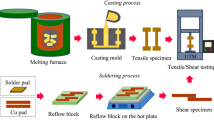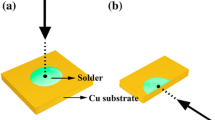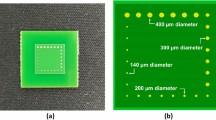Abstract
The reliability of SnPbAg solder joints containing gold (Au) under different aging conditions have been investigated. The solder joints were prepared by printing Sn62Pn36Ag2 solder paste on gold-plated copper (Cu) pads and then reflow soldering them. Subsequently, the joints underwent aging at temperatures of 75°C, 100°C, 125°C, and 150°C for durations of 100 h, 250 h, 500 h, and 1000 h, respectively. During the aging process, there was a gradual transition of Au from the AuSn4 phase to the (Cu,Au)6Sn5 phase, resulting in a phenomenon known as the “return of Au”. The intermetallic compound (IMC) layer within the solder joint primarily consisted of the Cu3Sn phase and the (Cu,Au)6Sn5 phase, with the IMC layer progressively thickening as the aging time extended. Through the calculation of the growth rate constant (k) and activation energy (Q) for both the Cu3Sn phase and the (Cu,Au)6Sn5 phase, it was found that the growth rate of the (Cu,Au)6Sn5 phase surpassed that of the Cu3Sn phase. Upon reaching an aging parameter of 150 °C for 1000 h, an essentially continuous Pb-rich layer formed above the IMC layer within the solder joint. Following shear force tests, the solder joint experiences ductile fracture, with the mechanical properties of the joint significantly compromised due to the presence of the Pb-rich layer.







Similar content being viewed by others
References
M. Abtew and G. Selvaduray, Lead-free solders in microelectronics. Mater. Sci. Eng. R-Rep. 27, 95 (2000).
Y.S. Lai, P.F. Yang, and C.L. Yeh, Experimental studies of board-level reliability of chip-scale packages subjected to JEDEC drop test condition. Microelectron. Reliab. 46, 645 (2006).
H.K. Yeo and K.H. Han, Wetting and spreading of molten SnPb solder on a Cu-10%Nb micro-composite. J. Alloys Compd. 477, 278 (2009).
S. Li, C. Hang, Q. Guan, X. Tang, D. Yu, Y. Ding, and X. Wang, The microstructure evolution and failure mechanism of Sn37Pb solder joints under the coupling effects of extreme temperature variation and electromigration. Mater. Today Commun. 36, 106651 (2023).
P.T. Vianco, A review of interface microstructures in electronic packaging applications: soldering technology. JOM 71, 158 (2019).
S. Gao, Z. Chen, A. Hu, M. Li, and K. Qian, Electrodeposited Ni microcones with a thin Au film bonded with Au wire. J. Mater. Process. Technol. 214, 326 (2014).
Chen, Y.J., Huang, K.Y., Chen, H.T., and Kao, C.R. in 2013 IEEE International Symposium on Advanced Packaging Materials (2013), p. 102
J.A. Davis, M.J. Bozack, and J.L. Evans, Effect of (Au, Ni)Sn4 evolution on Sn-37Pb/ENIG solder joint reliability under isothermal and temperature-cycled conditions. IEEE Trans. Compon. Packaging Technol. 30, 32 (2007).
C.F. Yang and S.W. Chen, Interfacial reactions in Au/Sn/Cu sandwich specimens. Intermetallics 18, 672 (2010).
Y. Liu, Y.T. Chen, S. Gu, D.W. Kim, and K.N. Tu, Fracture reliability concern of (Au, Ni)Sn4 phase in 3D integrated circuit microbumps using Ni/Au surface finishing. Scr. Mater. 119, 9 (2016).
R. Wheeling, P. Vianco, S. Williams, L. Jauregui, and D.F.S. Gallis, Impact of gold thickness on interfacial evolution and subsequent embrittlement of tin-lead solder joints. J. Electron. Mater. 51, 7337 (2022).
W.L. Shih, T.L. Yang, H.Y. Chuang, M.S. Kuo, and C.R. Kao, Inhibition of gold embrittlement in micro-joints for three-dimensional integrated circuits. J. Electron. Mater. 43, 4262 (2014).
L.Y. Hsiao, G.Y. Jang, K.J. Wang, and J.G. Duh, Inhibiting AuSn4 formation by controlling the interfacial reaction in solder joints. J. Electron. Mater. 36, 1476 (2007).
D. Susan, P. Vianco, R. Grant, P. Hlava, A. Kilgo, and G. Zender, Microscopy of solder joint failures due to gold intermetallic embrittlement. Microsc. Microanal. 11, 1600 (2005).
Susan, D.F., Vianco, P.T., Rejent, J.A., Martin, J.J. and Hlava, P.F. in 3rd International Brazing and Soldering Conference (2006), p. 26
P.T. Vianco, A.C. Kilgo, B.M. McKenzie, R.L. Grant, and S. Williams, Interface embrittlement between 63Sn-37Pb solder and Au layer—Part 1: physical metallurgy of liquid-state and solid-state reactions. J. Electron. Mater. 51, 6431 (2022).
R. Tian, C. Hang, Y. Tian, and J. Xu, Brittle fracture of Sn-37Pb solder joints induced by enhanced intermetallic compound growth under extreme temperature changes. J. Mater. Process. Technol. 268, 1 (2019).
T. Laurila, V. Vuorinen, T. Mattila, and J.K. Kivilahti, Analysis of the redeposition of AuSn4 on Ni/Au contact pads when using SnPbAg, SnAg, and SnAgCu solders. J. Electron. Mater. 34, 103 (2005).
M. Kerr and N. Chawla, Creep deformation behavior of Sn-3.5Ag solder/Cu couple at small length scales. Acta Mater. 52, 4527 (2004).
M. He, Z. Chen, and G. Qi, Solid state interfacial reaction of Sn-37Pb and Sn-3.5Ag solders with Ni-P under bump metallization. Acta Mater. 52, 2047 (2004).
G. Khatibi, A.B. Kotas, and M. Lederer, Effect of aging on mechanical properties of high temperature Pb-rich solder joints. Microelectron. Reliab. 1(85), 1–1 (2018).
P.T. Vianco, Understanding the reliability of solder joints used in advanced structural and electronics applications: part 2—reliability performance. Weld. J. 96, 83s (2017).
Acknowledgments
The authors would like to take this opportunity to express their sincere appreciation to Chinese Academy of Engineering Physics for its support of this work.
Author information
Authors and Affiliations
Corresponding authors
Ethics declarations
Conflict of interest
The authors declare that they have no conflict of interest.
Additional information
Publisher's Note
Springer Nature remains neutral with regard to jurisdictional claims in published maps and institutional affiliations.
Rights and permissions
Springer Nature or its licensor (e.g. a society or other partner) holds exclusive rights to this article under a publishing agreement with the author(s) or other rightsholder(s); author self-archiving of the accepted manuscript version of this article is solely governed by the terms of such publishing agreement and applicable law.
About this article
Cite this article
Bi, Y., Guo, W., Wang, S. et al. The Effect of Thermal Aging on the Mechanical Properties of Gold-Containing Solder Joints. J. Electron. Mater. (2024). https://doi.org/10.1007/s11664-024-11264-w
Received:
Accepted:
Published:
DOI: https://doi.org/10.1007/s11664-024-11264-w




